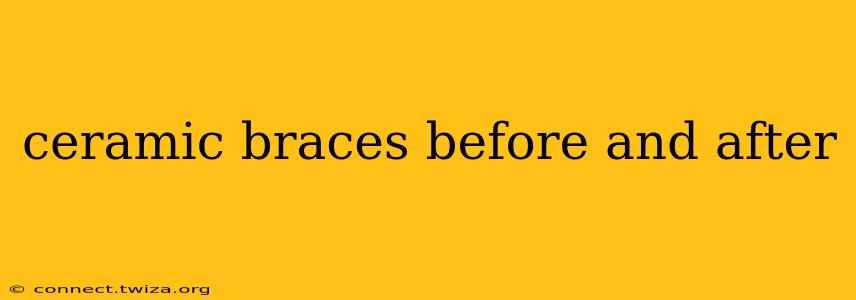Ceramic braces have become a popular choice for adults and teens seeking straighter teeth without the noticeable metal look of traditional braces. This comprehensive guide explores the ceramic braces before and after experience, addressing common questions and concerns. We'll delve into the process, benefits, drawbacks, and what you can expect throughout your treatment.
What are Ceramic Braces?
Ceramic braces utilize tooth-colored brackets made from a ceramic material, usually polycrystalline alumina. These brackets blend seamlessly with the natural color of your teeth, making them far less visible than traditional metal braces. The archwire, which connects the brackets and applies pressure to move the teeth, can be either metal or tooth-colored. While tooth-colored wires are less noticeable, they are also slightly less strong.
Ceramic Braces Before & After: The Transformation
The transformation with ceramic braces is gradual but significant. Before treatment, you'll have a consultation where your orthodontist will assess your teeth and create a treatment plan. This includes taking X-rays and impressions to create a detailed model of your mouth. The "before" photos will document your initial teeth alignment.
After the braces are placed, you'll see subtle shifts in your teeth over time. Regular adjustments by your orthodontist will gradually move your teeth into their proper positions. The "after" photos, taken after the braces are removed, will reveal a straighter, more aligned smile. The exact timeframe for treatment varies depending on individual needs and complexity of the case, typically ranging from 12 to 30 months.
What to Expect During Treatment?
How long does it take to get used to ceramic braces?
Initially, you may experience some discomfort and sensitivity, especially during the first few days after the braces are placed and following adjustments. Most patients adjust within a week, but it is important to follow your orthodontist's recommendations for pain management. This usually involves over-the-counter pain relievers. Eating may also feel a little strange initially; we'll discuss diet considerations in detail below.
What are the benefits of ceramic braces?
- Improved Aesthetics: The primary benefit is the improved appearance. They are far less noticeable than traditional metal braces.
- Improved Oral Health: Straightening your teeth can improve oral hygiene by making it easier to clean and floss, reducing the risk of cavities and gum disease.
- Improved Bite & Jaw Function: Correcting misalignment can improve your bite and jaw function, reducing stress on the jaw joints (TMJ).
- Improved Self-Confidence: A straighter smile can significantly boost self-esteem and confidence.
What are the drawbacks of ceramic braces?
- Higher Cost: Ceramic braces are generally more expensive than metal braces.
- More Prone to Staining: The ceramic material can stain more easily than metal braces, especially with certain foods and drinks like coffee, tea, and red wine. Meticulous oral hygiene is crucial.
- Slightly Longer Treatment Time: In some cases, ceramic braces may require slightly longer treatment times than metal braces.
- More prone to breakage: While durable, ceramic brackets can be more prone to breakage than metal ones. Careful adherence to your orthodontist's instructions is vital to minimize this risk.
What should I eat with ceramic braces?
It's crucial to avoid hard, crunchy, or sticky foods that could damage or break the brackets. This includes hard candies, popcorn, nuts, ice, and chewing gum. Opt for softer foods initially and gradually reintroduce other foods as you become more comfortable.
How often do I need to visit the orthodontist?
You'll need regular check-up appointments with your orthodontist for adjustments. These appointments typically occur every 4-6 weeks, allowing your orthodontist to monitor progress and make necessary modifications.
How do I clean my ceramic braces?
Maintaining excellent oral hygiene is essential with ceramic braces. You'll need to brush thoroughly after each meal using a soft-bristled toothbrush and fluoride toothpaste. Interdental brushes and floss threaders are also important tools for cleaning around the brackets. Your orthodontist can show you the best techniques.
Ceramic Braces Before and After: Long-Term Results
After your treatment is complete, your orthodontist will remove the braces. You'll likely wear a retainer to maintain the results. The long-term success of your treatment depends on diligent retainer wear as prescribed. Your beautiful, straight smile will be a testament to your commitment to improving your dental health and appearance.
Disclaimer: This information is for general knowledge and should not be considered medical advice. Consult with a qualified orthodontist for personalized recommendations and treatment planning.
